Are you a wine enthusiast dreaming of creating the perfect haven for your prized collection? Designing a home wine cellar is an exciting venture, and a well-thought-out design not only enhances storage but also provides a dedicated space for entertaining.
But before you start stocking those shelves, there’s one crucial element you can’t afford to overlook: the flooring.
In this guide, we’ll discuss wine cellar flooring ideas and the top five factors to consider when choosing one.
Welcome to Didi Somm and Cheers!
Important Notice: The information in this article is for general and public information purposes only. It solely reflects Didi Somm’s or his Staff’s opinion, and no responsibility can be assumed for errors or omissions in the service’s contents. For details, please check the Disclaimer at the bottom of the homepage.
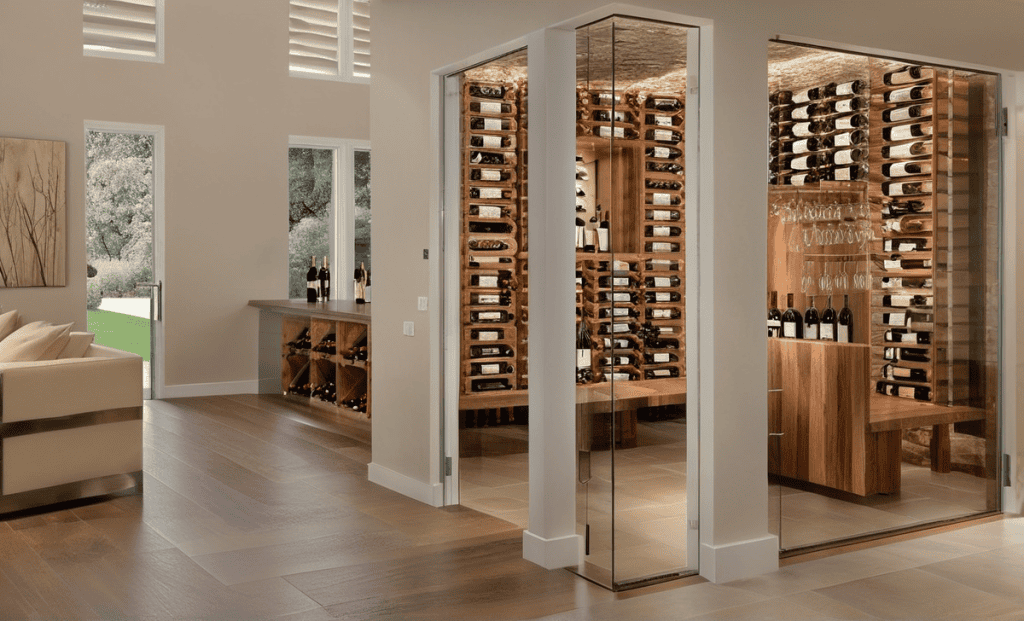
Key Takeaways
Temperature and humidity regulation are crucial for wine storage and preservation and are directly influenced by flooring choice.
Moisture resistance is essential to prevent damage to both the floor and wine collection.
Durability and weight capacity are vital considerations due to the heavy load of wine bottles and racks.
Easy-to-maintain flooring options help keep your cellar clean and hygienic.
The aesthetic appeal of your flooring contributes to the overall ambiance of your wine cellar.
The 5 Essential Factors for Choosing Wine Cellar Flooring
When designing a wine cellar, several factors come into play to ensure that your wine is stored in optimal conditions. The right temperature, humidity, and lighting are crucial elements that can affect the quality and longevity of your wine collection.
Additionally, the flooring choice can significantly impact your wine cellar’s functionality and aesthetics. Selecting a suitable floor material is essential to enhance your wine storage room’s overall design and ambiance.
1. Temperature and Humidity Regulation
The cornerstone of any wine cellar is its ability to maintain a consistent environment, which is essential for any wine room. Your flooring plays a pivotal role in this delicate balance. Opt for materials that contribute to temperature stability and humidity control, typically around 55°F (13°C) and 70% relative humidity.
Pro Tip: Cork flooring naturally regulates temperature and humidity, making it an excellent choice for wine cellars.
2. Moisture Resistance
Wine cellars are prone to moisture, which can wreak havoc on your flooring and, consequently, your wine collection. Choose materials that can withstand damp conditions without warping, mold growth, or deterioration. While wood flooring offers a classic and timeless appearance, adding warmth and richness to the space, it requires higher maintenance to prevent moisture damage.
Key Point: Rubber flooring is renowned for its moisture-resistant properties and can be an ideal option for wine cellars.
3. Durability and Weight Capacity
Your wine cellar floor needs to support not just foot traffic but also the considerable weight of wine racks, bottles, and possibly furniture. When designing your cellar, evaluating your space and preferences is crucial to ensure it meets your needs. Consider the load-bearing capacity of your chosen flooring material.
Did You Know? A case of 12 wine bottles can weigh up to 40 pounds (approx. 18 kg). Multiply that by your collection size, and you’ll see why durability matters!
4. Ease of Maintenance
Spills happen, even in the most carefully managed cellars. Select flooring that’s easy to clean and maintain to ensure your cellar remains pristine and hygienic.
Tip: Tile flooring is easy to maintain and comes in various styles to suit your aesthetic preferences.
5. Aesthetic Appeal
While functionality is paramount, the visual appeal of your wine cellar shouldn’t be an afterthought. Choose flooring that complements your cellar’s design and enhances the overall ambiance.
Style Suggestion: Stone flooring, such as limestone or travertine, can add a touch of elegance and timeless beauty to your wine cellar.
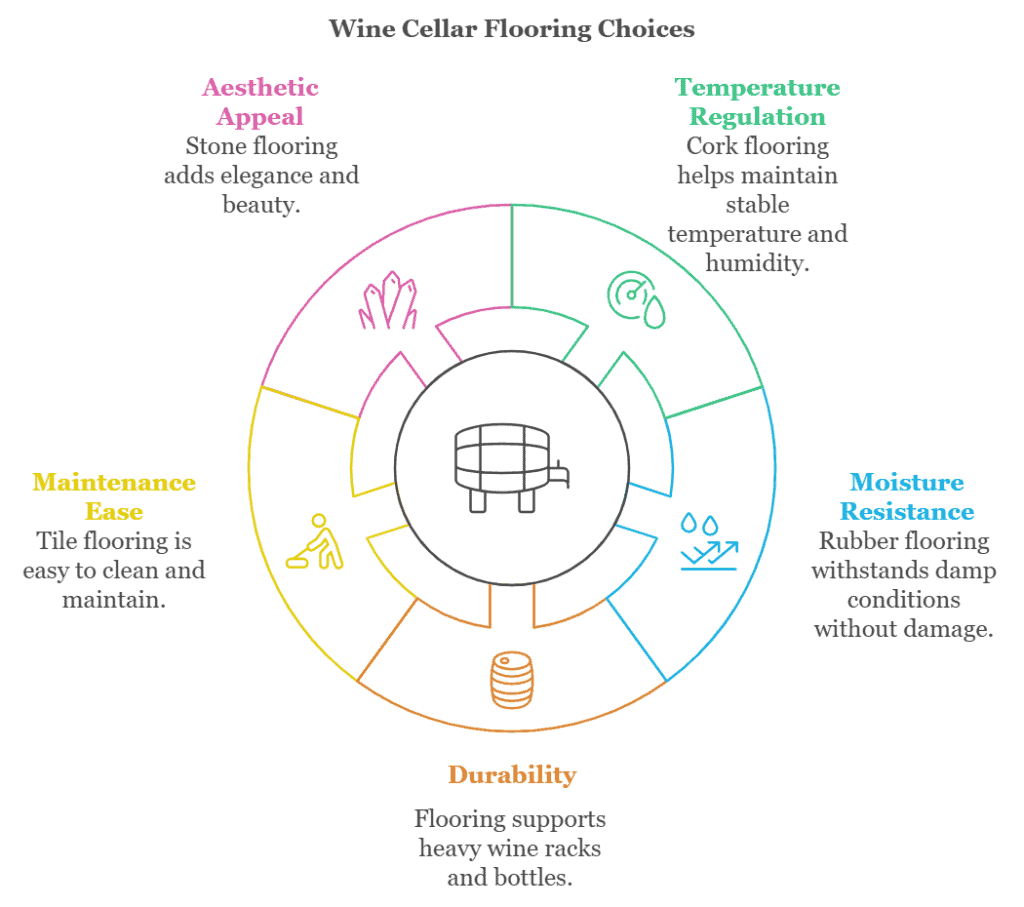
Popular Wine Cellar Flooring Options
Cork Flooring:
Pros
Cons
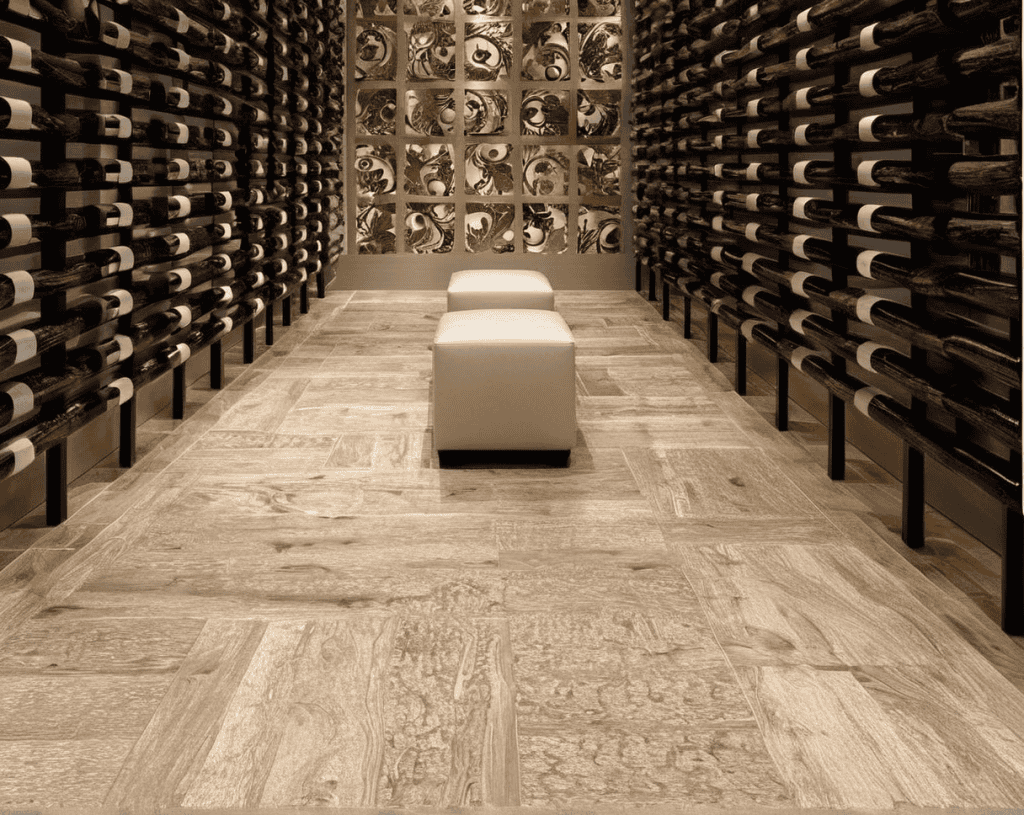
Rubber Flooring:
Pros
Cons

Stone Flooring:
Pros
Cons
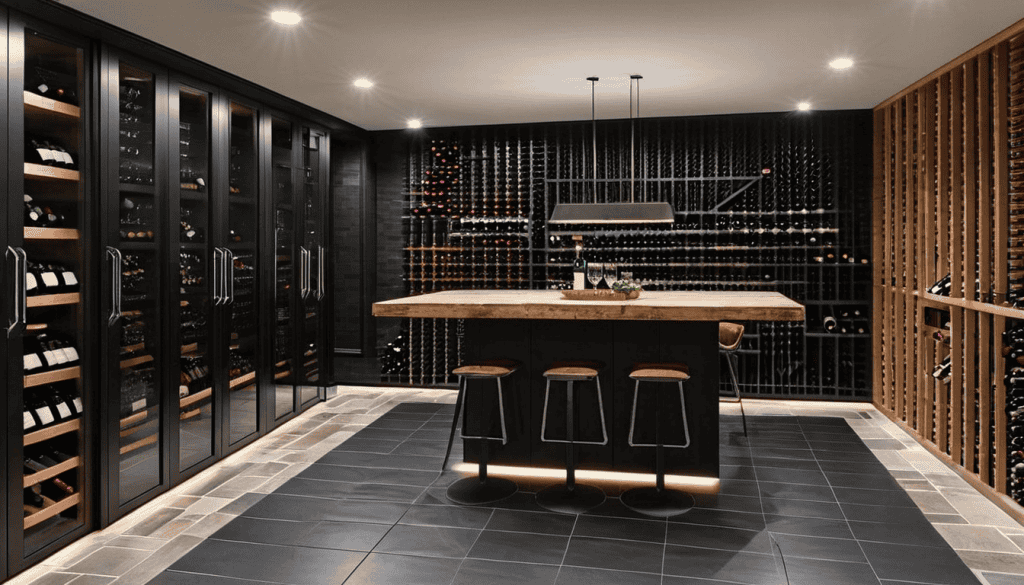
Tile Flooring:
Pros
Cons
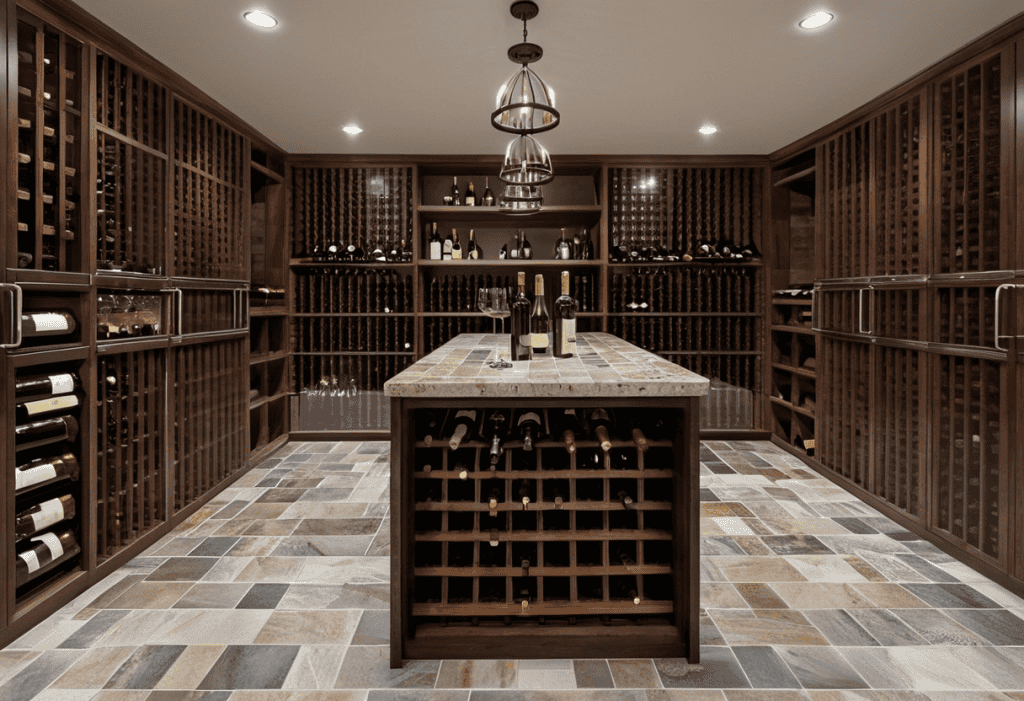
Epoxy Flooring:
Pros
Cons
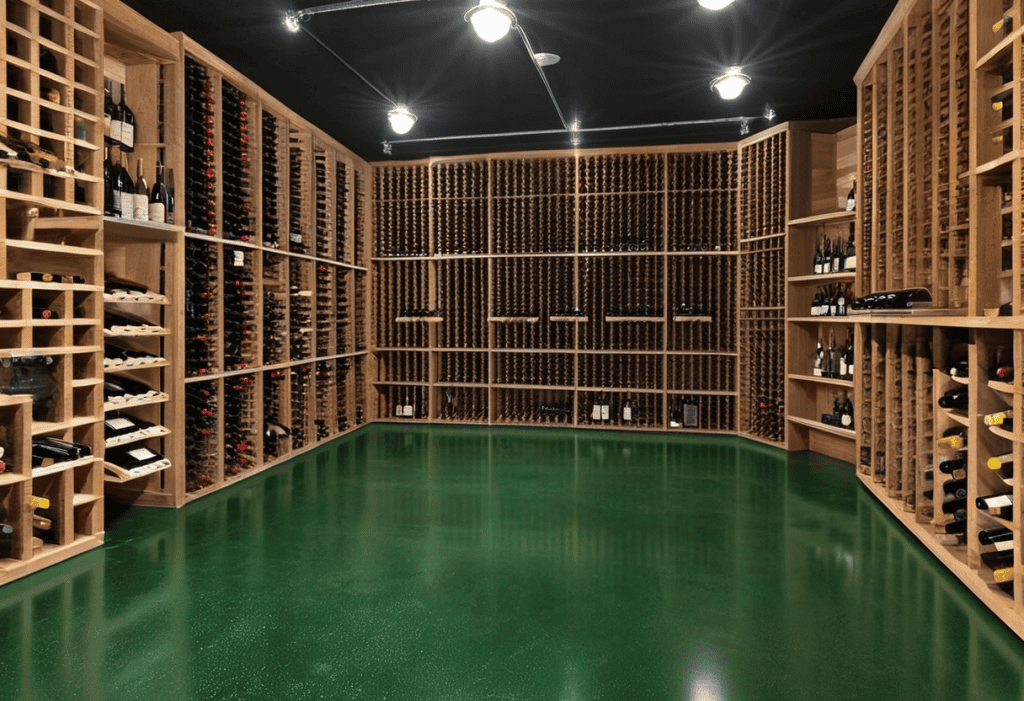
FAQs – wine Cellar Flooring Ideas
1. Q: Can I use hardwood flooring in my custom wine cellar?
A: While beautiful, hardwood is generally not recommended due to its susceptibility to moisture and temperature fluctuations. If you love the look of wood, consider engineered hardwood or wood-look tile instead.
2. Q: How important is insulation in wine cellar flooring?
A: Insulation is crucial for maintaining temperature stability. For optimal performance, consider adding an insulation layer beneath your chosen flooring material.
3. Q: Are there eco-friendly options for wine cellar flooring?
A: Yes! Cork flooring is a sustainable choice, as it’s harvested without harming the tree. Reclaimed stone or recycled rubber flooring are also environmentally friendly options.
4. Q: How often should I clean my wine cellar floor?
A: Regular cleaning is essential. Sweep or vacuum weekly and mop monthly, using cleaning products appropriate for your specific flooring material.
5. Q: Can I install radiant heating under my wine cellar floor?
A: It’s not recommended, as radiant heating can disrupt the cellar’s temperature balance and potentially damage your wine collection.
6. Q: What’s the best flooring for a small wine cellar or closet?
A: Cork or rubber tiles are excellent choices for smaller spaces. They offer easy installation and good insulation properties.
7. Q: How do I prevent mold growth on my wine cellar floor?
A: Choose mold-resistant materials, ensure proper ventilation, and maintain consistent humidity. Regular cleaning also helps prevent mold growth.
8. Q: Is it necessary to seal stone flooring in a wine cellar?
A: Yes, sealing stone flooring helps protect it from moisture and stains, which is particularly important in a wine cellar’s damp environment.
9. Q: Can I use carpet in my wine cellar?
A: Carpet is not recommended due to its tendency to trap moisture and harbor mold. Stick to hard, moisture-resistant surfaces.
10. Q: How thick should my wine cellar flooring be?
A: The thickness depends on the material, but aim for at least 1/2 inch to ensure adequate insulation and durability.
11. Q: Is it possible to DIY wine cellar flooring installation?
A: While some materials like cork or rubber tiles can be DIY-friendly, it’s often best to hire a professional to ensure proper installation, especially for moisture barriers and insulation.
12. Q: How do I choose the flooring that complements my wine rack design?
A: Consider the color and style of your wine racks. Neutral-toned flooring often works well, allowing your wine collection to be the focal point. For information about wine racks, please check Wine Racks America.
13. Q: Are there any flooring materials I should avoid in a wine cellar?
A: Avoid porous materials like untreated concrete, which can absorb moisture and affect cellar humidity. Also, steer clear of materials that off-gas, as this can taint your wine.
14. Q: How does flooring as part of the wine cellar design affect the resale value of my home?
A: A well-designed wine cellar with appropriate, high-quality flooring can be a significant selling point and potentially increase your home’s value.
15. Q: Can I use the same flooring in my tasting and storage areas?
A: You can use the same flooring throughout for a cohesive look. Just ensure it meets the requirements for both areas, particularly in terms of comfort for the tasting area and durability for the storage area.
Conclusion
Choosing the right flooring for your wine cellar is crucial in creating the perfect environment for your cherished collection. By considering temperature regulation, moisture resistance, durability, maintenance, and aesthetics, you’ll lay the groundwork for a cellar that preserves your wine and becomes a stunning showcase of your passion.
Remember, the right floor doesn’t just support your wine; it elevates the entire cellar experience. So, raise a glass and get ready to discover your wine cellar’s full potential!
For your reference, the latest articles by Didi Somm include:
- What is a Sweet Wine? – 7 Expert Insights
- How to Use Dry White Wine for Cooking? – Your Best Guide
- How to Build a Wine Cellar: 10 Expert Steps to Create Your Perfect Vino Haven
- Sip Smart: The Ultimate Guide to Low Alcohol Wine
- How to Read a Wine Label: 15 Expert Tips
- Built in Wine Refrigerator – 7 Best Solutions for You
Important Notice: The information in this article is for general and public information purposes only. It solely reflects Didi Somm’s or his Staff’s opinion, and no responsibility can be assumed for errors or omissions in the service’s contents. For details, please check the Disclaimer at the bottom of the homepage.



